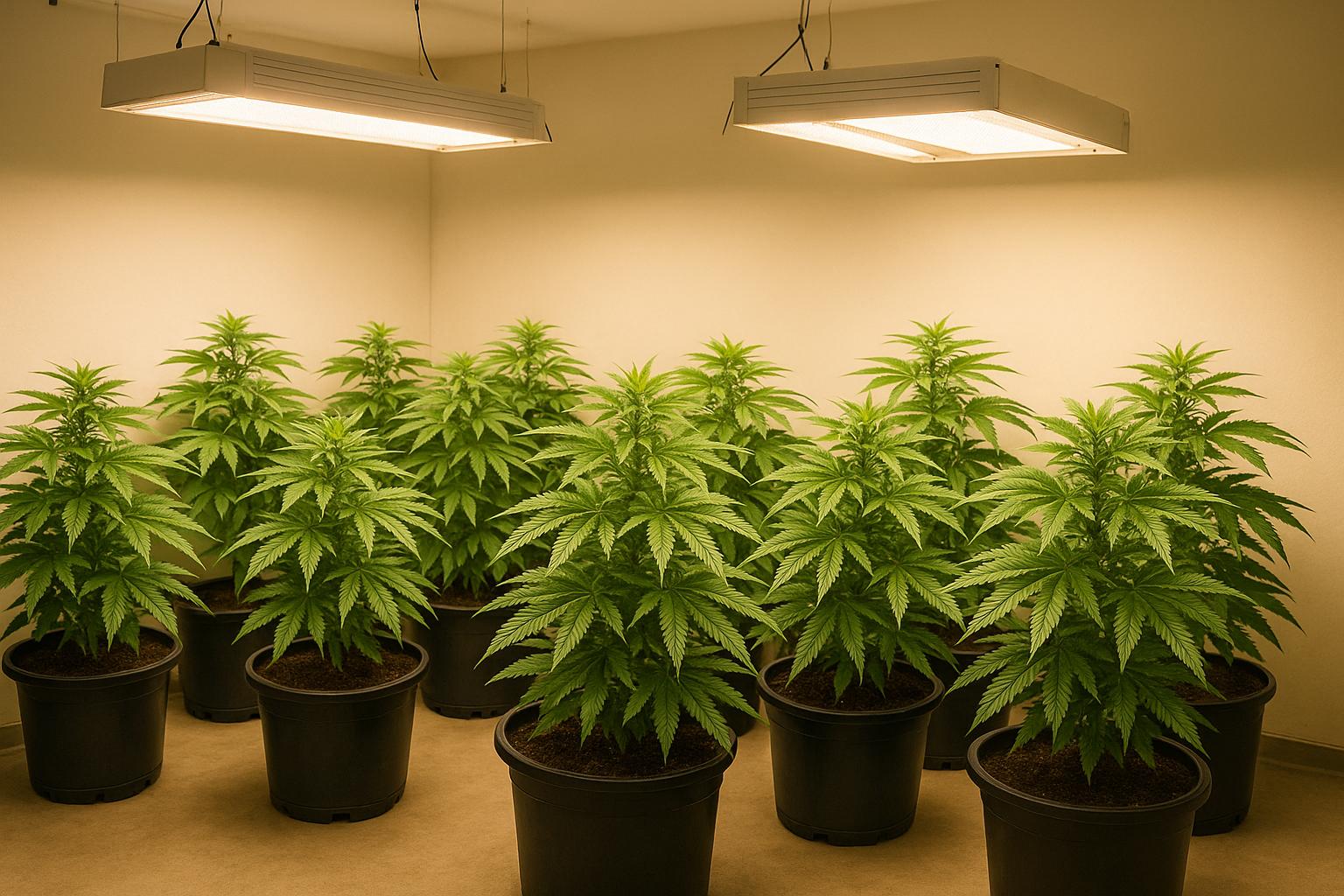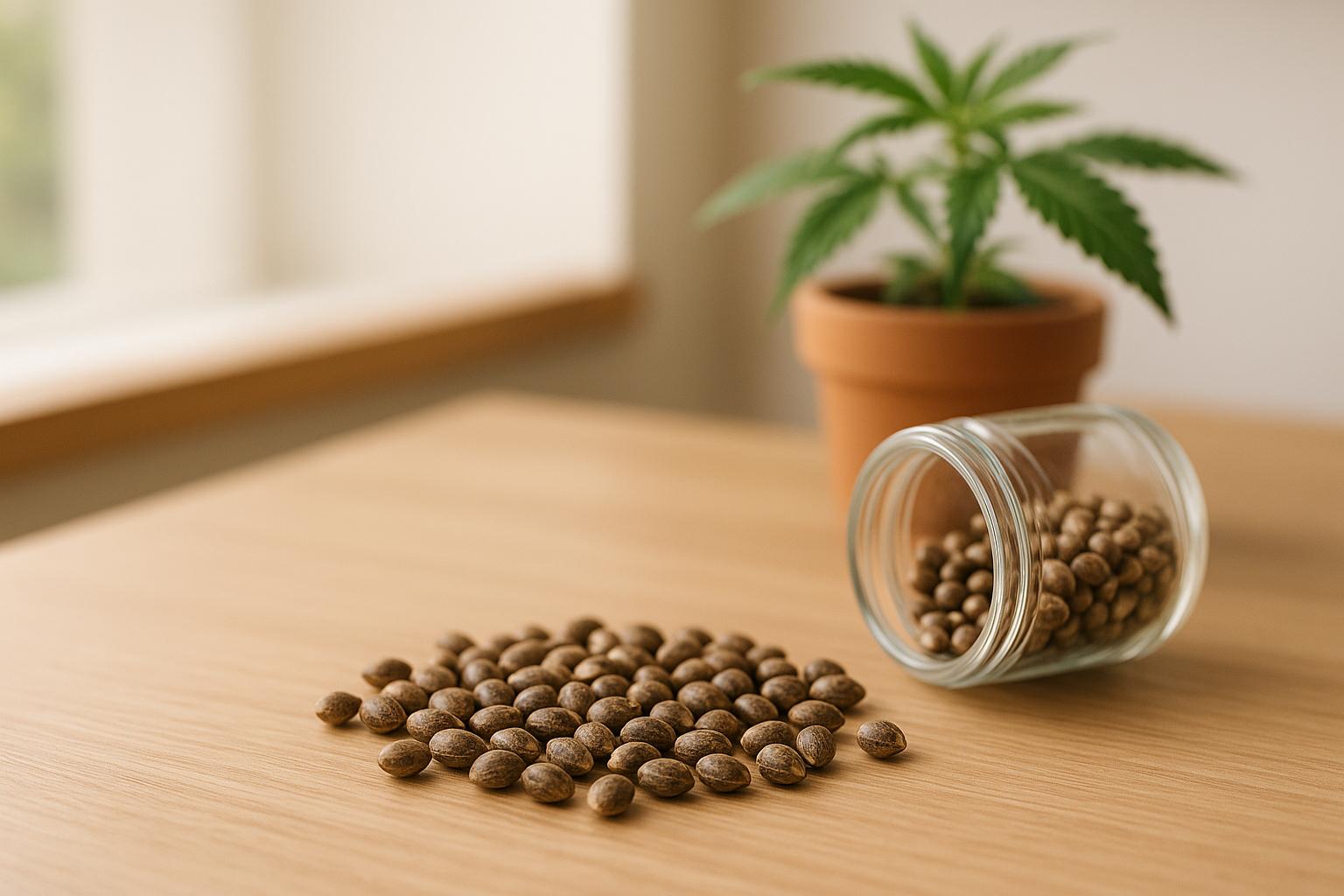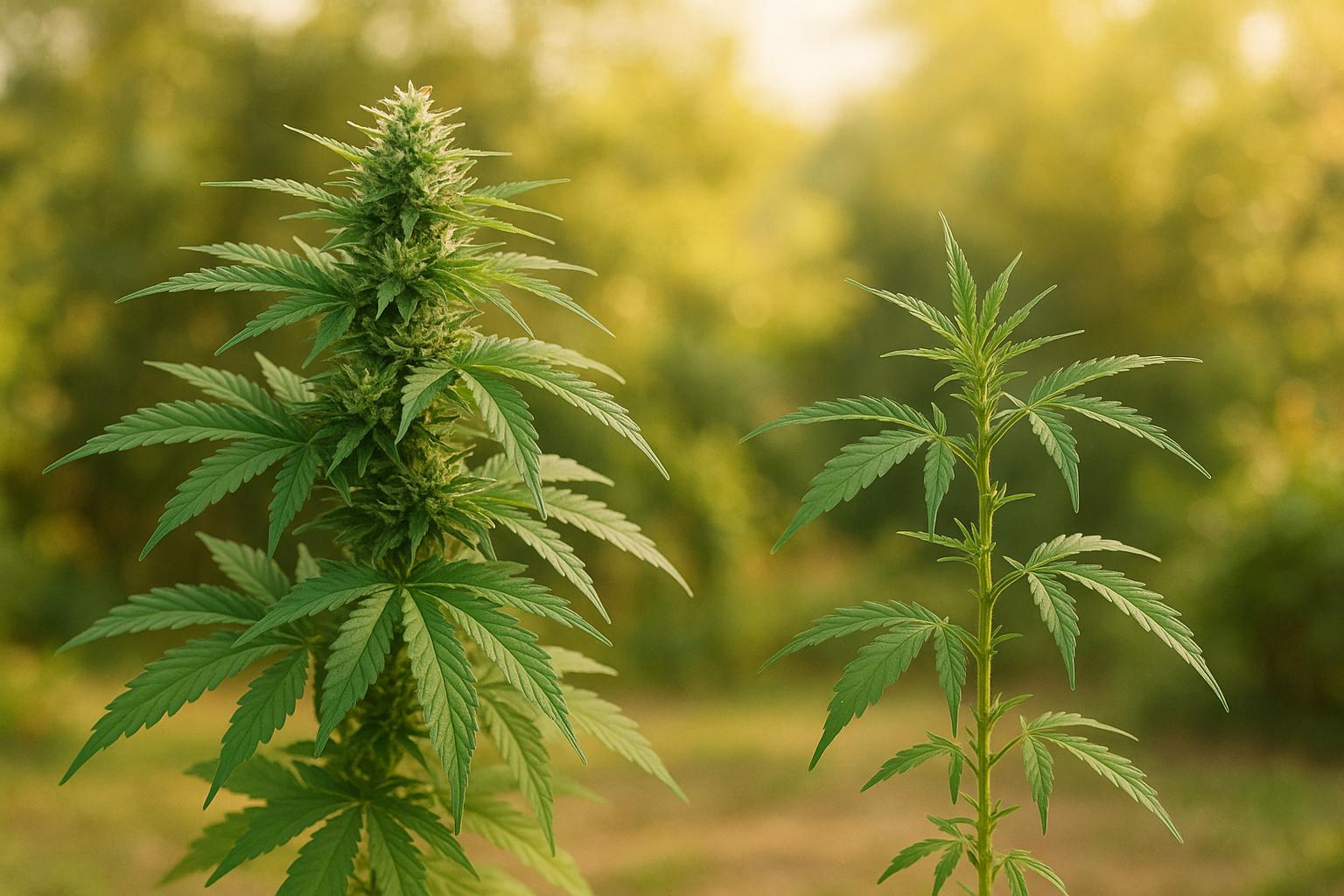Managing temperature and humidity is key to protecting cannabis crops from pests and diseases. Temperature adjustments help control pests like spider mites and aphids, while humidity management prevents fungal issues like powdery mildew and bud rot. Both factors directly impact plant health and yield, making them critical for growers.
Key Takeaways:
- Temperature Control: Targets pests, slows pathogen spread, and strengthens plant defenses. Ideal ranges:
- Vegetative stage: 70–78°F
- Flowering stage: 65–75°F
- Humidity Control: Prevents fungal and bacterial diseases. Key levels:
- Flowering stage: Below 50% relative humidity
- Combined Approach: Balancing both temperature and humidity creates optimal conditions for plant growth and pest prevention.
Quick Comparison:
| Factor | Temperature Control | Humidity Control |
|---|---|---|
| Primary Focus | Insect pests, some pathogens | Fungal and bacterial diseases |
| Adjustment Speed | Fast (with HVAC systems) | Slower |
| Energy Use | High | Lower |
| Stress on Plants | Possible with abrupt changes | Minimal with gradual changes |
| Best Stage | Vegetative | Flowering |
For best results, use both strategies together, monitor conditions in real-time, and maintain equipment regularly. A balanced environment ensures healthier plants and higher yields.
How Temperature Controls Pests and Diseases
Temperature Effects on Pests and Pathogens
Temperature plays a crucial role in shaping pest behavior and the growth of pathogens in cannabis cultivation. Many pests, such as spider mites, thrips, and aphids, thrive only within certain temperature ranges. When conditions stray outside these ranges, their activity and reproduction slow down significantly. Similarly, fungal pathogens like powdery mildew and botrytis flourish under moderate temperatures, while extremes in either direction can hinder their spread. Understanding these dynamics is key to managing pests and diseases effectively.
Best Temperature Ranges for Cannabis Growth Stages
Cannabis plants require specific temperature ranges tailored to their growth stages. For seedlings, gentle warmth is essential to encourage root development and minimize pest issues. During the vegetative stage, warm days paired with cooler nights support healthy growth and strengthen the plant's natural defenses. In the flowering stage, slightly cooler temperatures help reduce the risk of bud diseases and discourage pest activity by maintaining a noticeable day-to-night temperature difference. Without proper temperature management, these benefits can be lost, leaving plants more vulnerable.
Problems from Poor Temperature Control
When temperatures are extreme or fluctuate wildly, cannabis plants experience stress that weakens their ability to fend off pests and diseases. High temperatures can disrupt vital physiological processes and reduce the production of natural compounds that deter pests. On the other hand, low temperatures can slow down metabolism and nutrient absorption. Rapid temperature changes also lead to condensation, creating a prime environment for fungal infections. Poor temperature regulation not only compromises plant health but also impacts overall crop quality and yield.
How Humidity Controls Pests and Diseases
Humidity's Effect on Fungal and Bacterial Diseases
Excessive humidity creates the perfect environment for fungal pathogens like Botrytis (commonly known as bud rot), powdery mildew, and other molds to thrive. Dense buds are particularly vulnerable because they trap moisture, significantly increasing the likelihood of mold issues such as bud rot. Additionally, when temperatures drop below the dew point, condensation forms, further encouraging mold development. Managing humidity levels is a critical part of controlling these diseases and works hand-in-hand with temperature regulation as part of a comprehensive pest and disease management plan. Up next, we'll explore the ideal humidity levels for each stage of cannabis growth to help reduce these risks.
Temperature vs. Humidity: Direct Comparison
Benefits and Drawbacks of Each Method
Using temperature to manage growing conditions can disrupt pest lifecycles and slow down the spread of pathogens. Modern HVAC systems make it possible to adjust temperatures quickly, but maintaining consistent temperatures across larger grow areas can be tricky. Uneven heating or cooling often leads to localized zones where pests might thrive. Plus, sudden shifts in temperature can stress plants, making them more vulnerable to diseases.
On the other hand, controlling humidity is highly effective at suppressing fungal and bacterial diseases during the flowering stage. Dehumidification systems efficiently reduce moisture, keeping pathogens like powdery mildew and botrytis at bay. However, humidity adjustments don’t do much to control insect pests like spider mites or aphids. Additionally, keeping dehumidification equipment in good working order requires regular maintenance, and achieving even moisture levels across dense plant canopies can be a challenge.
Here’s a side-by-side breakdown of how temperature and humidity control stack up:
Side-by-Side Comparison: Temperature vs. Humidity
| Factor | Temperature Control | Humidity Control |
|---|---|---|
| Primary Focus | Targets insect pests and some pathogens | Prevents fungal and bacterial diseases |
| Speed of Adjustment | Allows for quick environmental changes | Slower to reduce moisture levels |
| Energy Demands | Higher energy use with HVAC systems | Lower energy needs with dehumidifiers |
| Uniformity | Can create uneven temperature zones | Offers more consistent moisture distribution |
| Plant Stress | May stress plants with abrupt changes | Lower risk when adjustments are gradual |
| Equipment Investment | Higher initial costs for HVAC systems | Lower initial costs for dehumidifiers |
| Maintenance | Requires regular filter changes and cleaning | Needs consistent upkeep for efficiency |
| Growth Stage Suitability | Best during vegetative growth | Crucial during flowering for bud protection |
| Seasonal Considerations | Effective year-round with proper management | Especially useful in high-humidity seasons |
While each method has its strengths, neither temperature nor humidity control alone is enough to create an ideal growing environment. Temperature adjustments offer a broader approach to pest control but require careful energy use to avoid plant stress. Humidity management, on the other hand, excels at disease prevention with lower energy costs but doesn’t address insect pests.
The most successful cannabis growers understand the importance of managing both temperature and humidity together. By balancing these two factors, you can create an environment that discourages both pests and pathogens while promoting healthy, vigorous plant growth.
sbb-itb-1add288
Combined Strategies for Climate Control
Tools and Methods for Managing Temperature and Humidity
Building an effective climate control system means using a combination of tools that work seamlessly together. A dependable HVAC system is at the heart of this setup, ensuring consistent heating and cooling. To avoid sudden temperature shifts that could stress plants, pair HVAC systems with variable frequency drives for smoother operation.
For managing humidity, commercial dehumidifiers are great for removing excess moisture, while humidifiers - like ultrasonic or evaporative models - can add moisture when the air is too dry, especially during winter months. Environmental monitoring systems tie everything together by providing real-time readings of temperature and humidity. Advanced controllers can manage multiple zones and make automatic adjustments, even sending smartphone alerts if conditions stray from the desired range.
Air circulation is another key factor. Use oscillating and exhaust fans to keep air moving gently, which helps prevent moisture buildup and heat pockets. This steady airflow creates a stable environment, which is essential for supporting healthy plant growth and effective pest management.
Managing Temperature and Humidity Together
Having the right tools is just the first step - synchronizing temperature and humidity is where the real magic happens. A balanced environment not only promotes healthy plant growth but also reduces the likelihood of pests and diseases. The vapor pressure deficit (VPD) is a critical measure here, as it reflects the relationship between temperature and humidity and affects how plants transpire. If the VPD gets too high, plants may close their stomata to conserve water, which can hinder their ability to absorb nutrients.
During the vegetative stage, aim for temperatures in the mid-70s°F with moderate relative humidity. This creates favorable VPD conditions for growth and can deter pests like spider mites, which thrive in hot, dry environments. It also minimizes the risk of fungal spores germinating.
The flowering stage requires even more precision. Cooler temperatures and lower humidity levels are essential to protect buds from issues like botrytis and powdery mildew. Make adjustments gradually, as abrupt changes in temperature or humidity can disrupt the balance. At night, use dehumidifiers and maintain airflow to counter rising humidity as temperatures drop. Seasonal changes also demand attention - summer may require extra cooling and dehumidification, while winter often calls for supplemental heating and humidification.
Adding Climate Control to IPM Programs
Climate control is a cornerstone of any effective integrated pest management (IPM) program. By creating an environment that discourages pests and diseases, growers can amplify the effectiveness of biological controls and strengthen plant defenses.
For example, predatory mites and other beneficial organisms thrive under well-regulated temperature and humidity levels. By fostering these conditions, you not only support these natural pest controllers but also make it harder for harmful pests to establish themselves. Additionally, plants grown in stable environments tend to develop stronger defenses and produce more compounds that naturally deter pests.
Real-time environmental monitoring systems are invaluable for timing interventions. For instance, tracking temperature and humidity can help predict when to release beneficial insects or apply organic treatments. Spider mites, for example, are more likely to appear in hot, dry conditions, while extended periods of high humidity can trigger rapid fungal growth.
To maintain these benefits, regularly service your equipment. Stable environmental conditions are key to a productive and healthy growing space.
Why Temperature & Humidity Can Make or Break Your Cannabis Grow
Conclusion: Choosing the Right Climate Priorities
Both temperature and humidity are essential factors for successful cultivation, and your priorities should align with your specific growing conditions. Deciding which factor to address first can significantly influence your harvest outcomes. The strategies outlined here build on earlier discussions about managing environmental controls effectively.
If pests like spider mites, aphids, or thrips are your main concern, focus on temperature control. Keeping temperatures between 70–78°F during vegetative growth and 65–75°F during flowering can create an environment that discourages these pests. Temperature adjustments often provide a quick and effective way to tackle infestations.
On the other hand, humidity management is critical when fungal diseases like powdery mildew, botrytis, or root rot threaten your plants. In humid climates or during wet seasons, using dehumidifiers becomes essential. Maintaining relative humidity below 50% during flowering is particularly important to prevent bud rot, which can destroy entire harvests in a matter of days.
For those new to growing, starting with temperature control is often the best approach. It requires less specialized equipment, and a well-functioning HVAC system with good air circulation can address multiple pest issues at once. Once you've established a stable temperature environment, you can add humidity control tools to create a more comprehensive system.
Experienced growers can take it a step further by integrating both temperature and humidity management using Vapor Pressure Deficit (VPD) calculations. This approach helps optimize plant health and enhances resistance to pests and diseases. Additionally, starting with strong, healthy plants is crucial. Plants with robust genetics are naturally more resilient to environmental stressors and pests.
To ensure a strong foundation, begin with quality cannabis seeds from reputable sources like Cannabis Seeds Directory. They connect growers with reliable genetics from trusted breeders worldwide. Healthy, vigorous plants are better equipped to handle minor environmental fluctuations and maintain their defenses against pests.
FAQs
What’s the best way to balance temperature and humidity for healthy cannabis growth and pest control?
To cultivate cannabis effectively and reduce pest problems, maintain daytime temperatures between 75-86°F and keep humidity levels around 50-60% during the vegetative stage. These conditions not only promote healthy plant growth but also help prevent mold and pests from taking hold.
Another crucial factor is managing the vapor pressure deficit (VPD). VPD plays a big role in ensuring plants transpire properly and absorb nutrients efficiently, which helps lower the risk of diseases. To keep your grow room in check, rely on tools like ventilation systems, fans, and dehumidifiers. Regularly monitoring and fine-tuning these conditions will help you maintain an environment where your plants can thrive.
What equipment is best for controlling temperature and humidity in cannabis cultivation?
Managing temperature and humidity effectively is crucial for successful cannabis cultivation, and multi-function grow room controllers can make this process much easier. These devices automate key environmental factors by monitoring and adjusting temperature, humidity, and light levels as needed. Some advanced models even control equipment like fans, lights, and dehumidifiers to maintain the perfect growing conditions for your plants.
To ensure accuracy, tools such as temperature sensors, hygrometers, and data loggers are invaluable. These devices provide precise measurements, helping you keep your grow room within the ideal range. Opting for equipment that combines these tools with automation features can save you time and help maintain a consistent environment for healthier plant growth.
What is Vapor Pressure Deficit (VPD) and how does it impact pest and disease control in cannabis cultivation?
Vapor Pressure Deficit (VPD) is a crucial factor in managing moisture levels and plant transpiration within cannabis grow environments. Getting the VPD just right can help plants thrive while reducing their vulnerability to pests and diseases.
If the VPD is too low, excess moisture can create a breeding ground for problems like mold and fungal infections. On the flip side, when VPD is too high, plants can become stressed, weakening their natural defenses and making them more prone to pest infestations. Keeping VPD in the optimal range not only promotes healthy transpiration but also boosts nutrient uptake, creating conditions that are less welcoming to pests and diseases. This balance ultimately supports healthier plants and better yields.



